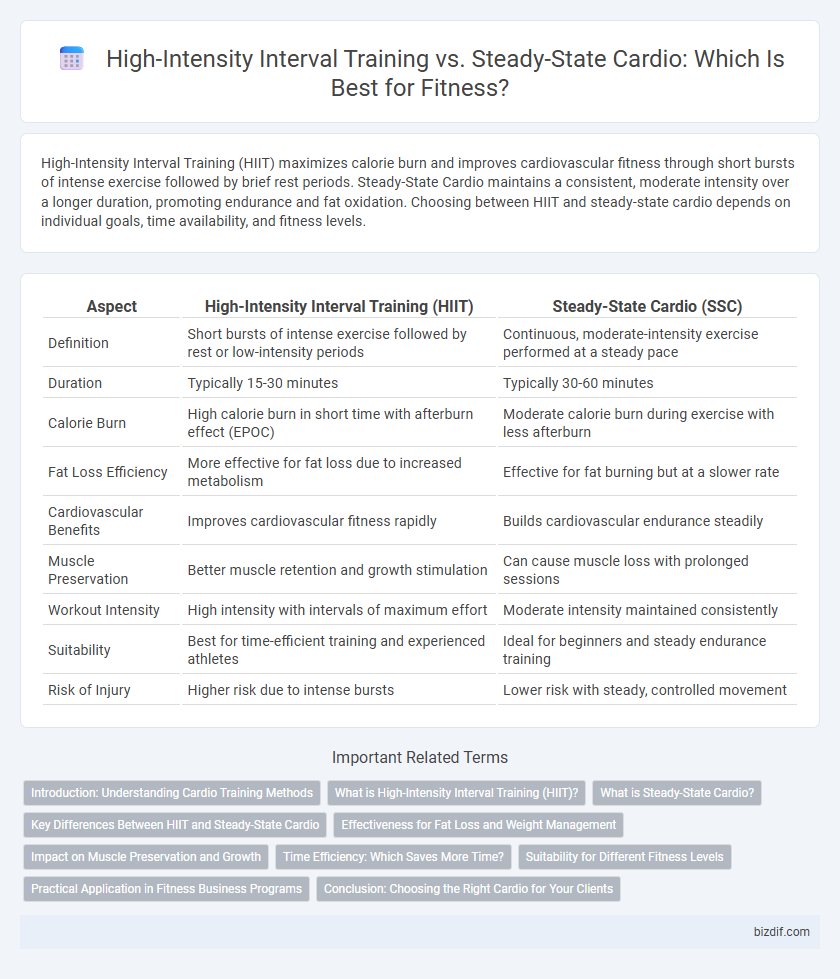High-Intensity Interval Training (HIIT) maximizes calorie burn and improves cardiovascular fitness through short bursts of intense exercise followed by brief rest periods. Steady-State Cardio maintains a consistent, moderate intensity over a longer duration, promoting endurance and fat oxidation. Choosing between HIIT and steady-state cardio depends on individual goals, time availability, and fitness levels.
Table of Comparison
| Aspect | High-Intensity Interval Training (HIIT) | Steady-State Cardio (SSC) |
|---|---|---|
| Definition | Short bursts of intense exercise followed by rest or low-intensity periods | Continuous, moderate-intensity exercise performed at a steady pace |
| Duration | Typically 15-30 minutes | Typically 30-60 minutes |
| Calorie Burn | High calorie burn in short time with afterburn effect (EPOC) | Moderate calorie burn during exercise with less afterburn |
| Fat Loss Efficiency | More effective for fat loss due to increased metabolism | Effective for fat burning but at a slower rate |
| Cardiovascular Benefits | Improves cardiovascular fitness rapidly | Builds cardiovascular endurance steadily |
| Muscle Preservation | Better muscle retention and growth stimulation | Can cause muscle loss with prolonged sessions |
| Workout Intensity | High intensity with intervals of maximum effort | Moderate intensity maintained consistently |
| Suitability | Best for time-efficient training and experienced athletes | Ideal for beginners and steady endurance training |
| Risk of Injury | Higher risk due to intense bursts | Lower risk with steady, controlled movement |
Introduction: Understanding Cardio Training Methods
High-Intensity Interval Training (HIIT) involves short bursts of intense exercise followed by recovery periods, maximizing calorie burn and cardiovascular improvement in less time. Steady-State Cardio maintains a consistent, moderate intensity level, promoting endurance and fat oxidation over extended sessions. Both methods enhance cardiovascular health but target different fitness goals and physiological responses.
What is High-Intensity Interval Training (HIIT)?
High-Intensity Interval Training (HIIT) involves short bursts of intense exercise followed by brief recovery periods, maximizing calorie burn and cardiovascular benefits in less time. HIIT improves aerobic and anaerobic fitness while boosting metabolism through increased excess post-exercise oxygen consumption (EPOC). Research shows HIIT sessions lasting 15-30 minutes can effectively enhance endurance, muscle strength, and fat loss compared to traditional steady-state cardio workouts.
What is Steady-State Cardio?
Steady-state cardio involves maintaining a consistent, moderate level of intensity over an extended period, typically 30 to 60 minutes, such as jogging, cycling, or swimming at a steady pace. This exercise method primarily utilizes aerobic metabolism, enhancing cardiovascular endurance and promoting fat oxidation. It is an effective approach for improving overall heart health and building stamina through sustained, rhythmic activity.
Key Differences Between HIIT and Steady-State Cardio
High-Intensity Interval Training (HIIT) alternates short bursts of intense exercise with recovery periods, enhancing cardiovascular fitness and promoting greater calorie burn in less time. Steady-State Cardio involves maintaining a consistent, moderate pace over an extended duration, improving endurance and fat metabolism. HIIT's anaerobic focus contrasts with Steady-State Cardio's aerobic emphasis, making each suitable for different fitness goals and energy system adaptations.
Effectiveness for Fat Loss and Weight Management
High-Intensity Interval Training (HIIT) significantly boosts metabolism and fat oxidation, leading to more effective fat loss in shorter workout durations compared to Steady-State Cardio. HIIT triggers excess post-exercise oxygen consumption (EPOC), which increases calorie burn hours after exercise, enhancing weight management. Steady-State Cardio supports endurance and maintains a steady calorie burn but generally results in slower fat loss progress than HIIT.
Impact on Muscle Preservation and Growth
High-Intensity Interval Training (HIIT) promotes muscle preservation and growth by combining short bursts of intense exercise with recovery periods, stimulating muscle fibers and increasing anabolic hormone production. Steady-State Cardio primarily burns calories through prolonged aerobic activity but may lead to muscle catabolism if done excessively without strength training. Incorporating HIIT can enhance muscle endurance and hypertrophy while minimizing muscle loss compared to traditional steady-state cardio routines.
Time Efficiency: Which Saves More Time?
High-Intensity Interval Training (HIIT) saves more time compared to steady-state cardio by delivering intense bursts of exercise in short durations, often 15-30 minutes, while steady-state cardio typically requires 45-60 minutes to achieve similar calorie burn and cardiovascular benefits. HIIT increases post-exercise oxygen consumption, boosting metabolism for hours after the workout, enhancing fat loss efficiency within a compressed timeframe. Studies indicate that HIIT sessions can burn as many calories as longer steady-state cardio sessions, making HIIT the superior choice for time-efficient fitness training.
Suitability for Different Fitness Levels
High-Intensity Interval Training (HIIT) offers a time-efficient workout ideal for intermediate to advanced fitness levels due to its intense bursts of activity and recovery periods. Steady-State Cardio provides a lower-impact, consistent pace better suited for beginners or those with joint concerns, enabling endurance building without excessive strain. Selecting between HIIT and Steady-State Cardio depends on individual fitness goals, current conditioning, and physical limitations to optimize results and minimize injury risk.
Practical Application in Fitness Business Programs
High-Intensity Interval Training (HIIT) offers fitness businesses scalable, time-efficient workouts that boost client retention through varied intensity and measurable results. Steady-State Cardio appeals to a broader demographic by providing low-impact, sustained exercise sessions ideal for endurance improvements and recovery phases. Integrating both methodologies into fitness programs maximizes client engagement, caters to diverse fitness levels, and drives higher revenue streams through personalized training options.
Conclusion: Choosing the Right Cardio for Your Clients
High-Intensity Interval Training (HIIT) offers superior calorie burn and improved metabolic rate in shorter sessions, making it ideal for clients seeking efficiency and fat loss. Steady-State Cardio enhances cardiovascular endurance and is better suited for clients prioritizing sustained aerobic capacity and lower injury risk. Selecting the right cardio depends on individual fitness goals, physical condition, and training preferences to optimize client outcomes.
High-Intensity Interval Training vs Steady-State Cardio Infographic

 bizdif.com
bizdif.com